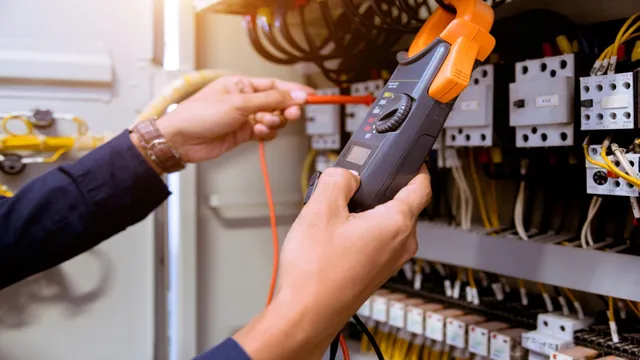Have you ever needed to test an electrical circuit but didn’t want to risk electrocution? That’s where a non-contact voltage tester comes in handy! This nifty tool allows you to detect electrical fields without even touching the wire. It’s perfect for those who are new to electrical work or simply want to be extra cautious. In this blog post, we’ll go over how to use a non-contact voltage tester and give you some tips on finding the best one for your needs.
So, let’s get started!
What is a Non Contact Voltage Tester?
If you’re looking for a safe and simple way to check for voltage in an object, a non-contact voltage tester is an effective tool to use. It’s a device that helps detect electrified circuits without the need for any physical contact with the circuit’s source. To use a non-contact voltage tester, you need to hold it close to the electrical device or wire you want to check, making sure it is turned on or connected to power.
The tester will detect the electric field and provide you with audio or visual signals to indicate if electricity is present. This tool is usually used by electricians to test circuits and ensure safety when performing repairs. With this tool, you can test an electrical circuit without making contact with a live wire, reducing the risk of electrical shock.
It’s an essential tool that can save you time and protect you from potential electric shock hazards. Remember that the non-contact voltage tester is not a substitute for proper electrical training and precautionary action.
How Does it Work?
If you’re planning to do electrical work in your home, you need to have the right tools to ensure your safety. One essential tool for every electrician or DIY enthusiast is a non-contact voltage tester. This device is designed to detect whether an electrical current is present in a wire or cable without the need for physical contact.
It works by using an electromagnetic field to sense the presence of live electricity. To use the device, hold it close to the wire or cable being tested, and the tool will indicate whether there’s a voltage present. This is a crucial tool for anyone working with electrical wiring as it can help you avoid shocks and electrocution.
Remember, when working with electricity, safety should always be your top priority.

Types of Non Contact Voltage Testers
A non contact voltage tester is a tool that allows an electrician to detect voltage from a safe distance without having to physically touch the wires or circuit being tested. It operates on the principle of electromagnetic induction and uses a high frequency signal to detect voltage. There are several types of non contact voltage testers, including pen-type testers, clamp meters, and infrared thermometers.
Pen-type testers are the most common and portable type, they look like a pen and are able to detect voltage when held close to an insulated wire. Clamp meters are used to measure current, voltage, and resistance, and are suitable for larger electrical systems. Infrared thermometers can measure surface temperature and are useful for detecting hot spots in electrical systems.
Choosing the right type of non contact voltage tester depends on the specific application and requirements of the user. Overall, using a non contact voltage tester is a safe and efficient way to detect voltage in electrical systems.
When to Use a Non Contact Voltage Tester
Are you unsure whether there is an electrical current running through a wire or outlet before you touch it? That’s where a non-contact voltage tester comes in handy. These handy devices allow you to check for the presence of an electrical current without having to make physical contact with the object in question. To use a non-contact voltage tester, make sure it is turned on and hold it close to the wire or outlet.
If a current is detected, the tester will light up or make a sound. This device is particularly useful for DIY tasks, such as changing light fixtures or checking for a blown fuse. However, it’s important to note that a non-contact voltage tester should never replace proper electrical safety practices or the use of other testing equipment.
Safety Precautions to Take
Using a non contact voltage tester can be a very effective way to ensure your safety when working with electrical systems. You want to make sure that you use this tool whenever you are unsure whether a wire is live or not. It is always better to err on the side of caution when working with electricity, as the consequences of an electrical shock can be severe.
Using a non contact voltage tester is a quick and easy way to determine whether a wire is live or not without having to touch it directly. Simply hold the tester near the wire and wait for a flashing light or beep to indicate that it is live. This will give you the information you need to proceed with caution and ensure that you stay safe when working with electrical systems.
Step-by-Step Guide for Using a Non Contact Voltage Tester
A non-contact voltage tester is a valuable tool that helps determine if electrical wires, outlets, and switches are live without requiring direct contact. This type of device can be used in a variety of situations, particularly when working with live wires or circuits. Whether you’re an electrician or a DIY enthusiast, a non-contact voltage tester can make electrical projects a lot safer and easier.
You can use it to detect hot wires, broken wires, or even check if your outlets are grounded. It’s also handy for detecting voltage before you start working on electrical wiring or appliances. To use the tester effectively, you simply need to hold it close to the source of electrical current and observe the results.
The device will either light up or beep when voltage is detected. With a non-contact voltage tester, you can quickly and confidently determine whether an electrical circuit is live or not, without touching any wires, and avoid potential electrical hazards.
Tips and Tricks for Accurate Measurements
When it comes to electrical work, safety should always be your top priority. That’s why it’s important to know when to use a non-contact voltage tester. These testers can detect the presence of electrical current without direct contact, which can help prevent accidental electrocution.
Non-contact voltage testers are especially useful when working with outlets, switches, and light fixtures, as well as when troubleshooting electrical circuits. Just hold the tester near the electrical components and the device will indicate if there is any electrical current present. It’s important to note that a non-contact voltage tester should not be used to measure voltage levels, but rather to detect the presence or absence of current.
As always, when working with electricity, it’s better to be safe than sorry.
Conclusion
Using a non contact voltage tester is like having a superhero power in the palm of your hand – it allows you to detect dangerous levels of electricity without actually touching anything. It’s like a safety glove for your senses, protecting you from potential shocks and saving you from electrical mishaps. So next time you’re tackling a DIY project or just want to make sure your electrical devices are properly powered, remember to wield your non contact voltage tester with confidence and caution – you never know when your powers might come in handy!”
FAQs
What is a non-contact voltage tester and how does it work?
A non-contact voltage tester is a device that allows you to detect the presence of electrical voltage without physically touching any wires. It works by sensing the electric field generated by an energized object.
How do you use a non-contact voltage tester to check if a circuit is live?
Hold the tester close to the wire or circuit breaker you want to test, making sure not to touch it. If the tester beeps or lights up, it means the circuit is live and you should not touch it.
Can a non-contact voltage tester detect low voltage?
Yes, some non-contact voltage testers can detect low voltage, usually above 12 volts. However, it’s important to check the specifications of your tester to ensure it can detect the voltage you are testing.
Is it safe to use a non-contact voltage tester around water or in damp conditions?
No, it’s not safe to use a non-contact voltage tester around water or in damp conditions. You should only use the tester in dry conditions and refrain from touching wet or damp surfaces.
What are some safety precautions to take when using a non-contact voltage tester?
Always read the instructions and follow the manufacturer’s guidelines for safe use. This includes wearing protective gear like goggles and gloves, as well as turning off the power to the circuit you are testing before using the tester.
Can a non-contact voltage tester be used to test DC voltage?
It depends on the specific model of the tester. Some non-contact voltage testers can only detect AC voltage, while others can detect both AC and DC voltage. Check the specifications of your tester to confirm its capabilities.
What are some common issues that can cause a non-contact voltage tester to produce false readings?
False readings may occur if the tester is placed too close to other electrical wires or if there is interference from nearby electronic devices. Additionally, low battery power or a faulty tester can also cause false readings.






